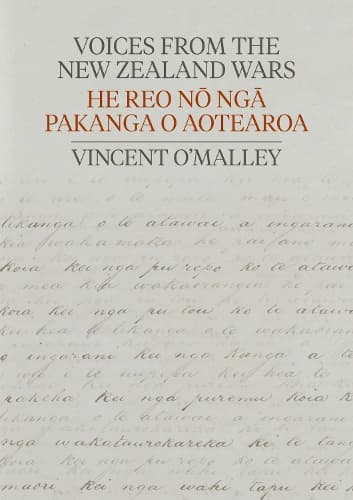Review: Voices from the New Zealand Wars – He Reo nō ngā Pakanga o Aotearoa
Reviewed by David Littlewood
Public interest in the New Zealand Wars is, at long last, becoming widespread. After decades of being pushed to the margins, these formative conflicts are finally being viewed as having just as much influence, if not more, on the shaping of Aotearoa New Zealand’s history and society than the two world wars.
Vincent O’Malley has played an integral role in this shift through his tireless advocacy and through his acclaimed books The Great War for New Zealand: Waikato 1800-2000 and The New Zealand Wars Ngā Pakanga o Aotearoa. By combining an incredibly rich set of sources – extracts from diaries, memoirs, letters, official documents and newspaper reports – with meticulous scholarship and a perfect editorial balance, O’Malley’s latest work will undoubtedly further efforts to raise the New Zealand Wars even higher in the national consciousness.
Perhaps the most difficult challenge when presenting a collection of extracts is in striking the right balance between providing context and ‘letting the sources speak for themselves.’ Simply reproducing the extracts with little or no commentary risks obscuring the bigger picture and making a book hard to follow. On the other hand, wielding too heavy an editorial pen risks taking the focus away from the extracts and imposing too much structure on events that were inherently messy and fragmented.
O’Malley has adeptly avoided both these potential pitfalls. He provides just enough background to each text to ensure the reader can comprehend its key features, while also presenting the extracts at length – some cover three or four pages – and as they were originally written, complete with idiosyncratic spelling and confronting language. It is particularly welcome to see several extracts presented first in te reo Māori, followed by a full English translation.
The extracts encompass a broad spectrum of voices and all the major battles of the New Zealand Wars. Some are the writings of well-known individuals like Hone Heke Pokai, Te Rauparaha, William Gilbert Mair, Gustavus von Tempsky and George Whitmore. Many others come from those ‘ordinary’ people who constituted the majority in this and every other conflict but who so often receive little attention in sweeping historical narratives. Throughout, the experiences of generals, rangatira and politicians are matched by those of Māori warriors and civilians, missionaries, sailors and soldiers in the imperial and colonial forces and newspaper reporters. O’Malley has also gone to great lengths to unearth as many accounts from women as possible, both Māori and Pākehā.
The extracts paint a vivid and, at times, confronting picture. By hearing at length from such a wide range of participants, one gets a real sense of the difficult choices they frequently faced and of the assumptions, attitudes and prejudices that underlay their decisions. Several extracts showcase the competing pressures rangatira had to weigh up in deciding whether to resist or cooperate with the Crown and whether to fight against or alongside its armed forces.
Others detail the thinking behind land sales and confiscations and how these processes came to have such a devastating impact even in places where there was little or no fighting. The most difficult, although perhaps the most illuminating, extracts are those regarding some of the atrocities committed during the wars such as the killing of settler families at Matawhero or the deliberate burning down of a whare at Rangiaowhia while several Māori were inside. By including accounts that discuss these events from a variety of perspectives, O’Malley clearly demonstrates that the wars were complex, significant and divisive - both at the time and ever since.
Considerable credit must also go to the team at Bridget Williams Books as this is a visual treat as much as an intellectual one. The extracts themselves are crisply presented in an easy-to-read fashion. There are also plentiful black-and-white and colour images throughout, each of which helps to enhance the force and resonance of the extracts, rather than just being included for show. Many are portraits of the key protagonists but there are also numerous paintings, drawings and photographs. The maps of each campaign and the comprehensive timeline are another important part of the book’s success in situating individual events in their wider context.
The new Aotearoa New Zealand’s Histories curriculum rightly places considerable emphasis on Māori history and experiences of colonisation, with the New Zealand Wars as a focus point. When the curriculum is shortly rolled out, there will be a pressing need for resources that teachers can utilise in the classroom to discuss these areas in an engaging, informative and sensitive way. This book fits that criterion perfectly as well as being an essential read for anyone who wants to gain a deeper understanding of these formative conflicts in Aotearoa New Zealand’s history.
Reviewed by David Littlewood
